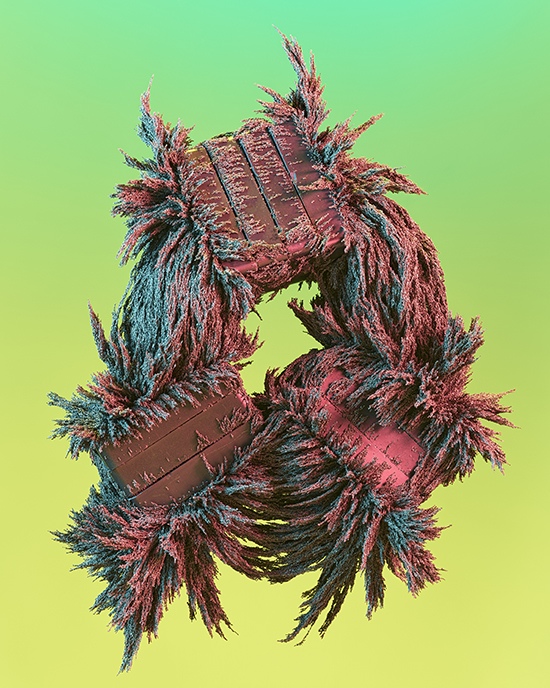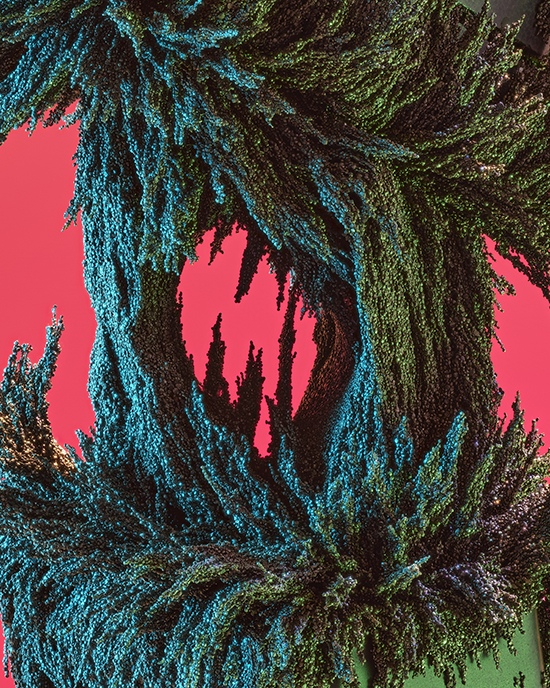
Zac Henderson’s Interpretation of Dark Matter through Photography
For the universe’s structure and evolution, Dark Matter plays an essential role. The direct detection of Dark Matter, which is believed to comprise 26% of the Universe, has been impossible to achieve because it does not absorb, reflect, or emit electromagnetic radiation; it is undetectable by any known means. (Source: Wikipedia)
Although people can not see Dark Matter, photographer Zac Henderson has taken on an artistic exploration to represent Dark Matter, or rather the effects of Dark Matter. He uses magnets and metallic grains to make visible the unseen matter and forces that surround us. Through Zac’s exploration, one can see the effects of Dark Matter are unpredictable in its presentation. Is it random? How many varieties can this invisible world form? These are some of the questions posed by Zac’s experimental photography.
We are delighted to showcase Zac’s photography and present to our readers a world that is still unknown and unseen.

Q: Your series on Dark Matter is truly amazing. It attempts to represent an invisible world that permeates the universe. Please share with us your background in photography and science.
A: First, thank you for the kind words; they mean a great deal. My history with photography began when I was 15. I fell in love with the camera and the different ways it could be used to capture a subject, and how the subject changed depending on the technique. I went to school to study photography at the Savannah College of Art and Design in Savannah, GA where I graduated with honors. My history in science is much more recent. In my twenties, I became interested in astronomy and astrophysics. I have no training in these fields, however, I am nonetheless fascinated by them and the implications they and other fields like quantum mechanics have on our relationship with reality.

Q: Why are you interested in Dark Matter and what does it mean to you?
A: I’m interested in any fundamental part of nature that eludes our direct detection, yet has profound effects. Dark matter is one of those interesting parts of the universe that is still being theorized about and explored. Its exotic nature is romantic to me and begs questions, the answers to which could potentially change our view of our place in the universe. Dark matter also presents a challenge in terms of inspiration, since it is, by definition, invisible to any direct detection. This allowed me to experiment and lean into aesthetic directions that other, more clearly defined subjects would forbid.
Q: How do you go about trying to display Dark Matter since no individual or institution has ever directly detected it?
A: My images are very much a fairytale imagining of what dark matter particles look like as seen from a higher dimension in which the particles and their effects on the ordinary matter are visible. Science may never be able to render images of dark matter at all, and even less likely in a way analogous to how my images are presented. However, that inability grants nearly unlimited artistic license for artists to explore. Again, it’s the not knowing that is itself part of the subject of the images.

Q: Please tell us about the three series of Dark Matter and how they are different from one another?
A: The first iteration of the series was the beginning of an experiment. As such it is monochromatic and displays a somewhat chaotic relationship between the magnets and filings. The second iteration is more refined, and was the first to introduce the focus stacking technique so that the full structure could be rendered with the same fidelity as any given focal plane. Though still mostly monochromatic, the images in the second iteration are actually full-color images, but with the limited natural palette of the magnets and iron grains. The third iteration is the most realized of all the series and incorporates intentional color and sculptural qualities not seen in the first two, along with further experimentation of how the magnets and grains can be pushed to interact in interesting, non-obvious ways.
Q: What do colors represent in your series? Do they have special meaning?
A: The colors in Dark Matter III are meant to underline the strangeness of these structures and their otherworldly namesake, as well as the imagined exotic space where these visualizations occur. The colors used in the series are bright and vibrant, sometimes complementary, and come from undisclosed locations.

Q: Please share with us your sources of inspiration, especially when you try to make visible an abstract concept.
A: Dark matter is itself invisible, but affects visual change at a distance. Magnetism is an invisible force that affects visual change at a distance, so I thought that this was a good starting point. I began acquiring magnets and iron grains to experiment with and explore what I could create as a physical object that could begin to do justice to the strangeness of the inspiration as well as the awe and respect I had for the actual scientific study of such an outlandish thing. After some time, I settled on the ceramic magnets and the particularly sized iron grains that are used in the series. In particular, I fell in love with the texture of the iron grains and their visual aesthetic, especially when manipulated to take on certain aspects of a magnetic field. The resulting sculptures are strange and otherworldly. They do not appear like objects we would typically come across in everyday life, or by any chance encounter.
Q: Do you have any upcoming projects or exhibitions that you would like to share with our readers?
A: I’m beginning a YouTube series about my work beginning this year. Videos will include behind-the-scenes, inspiration, philosophical positions, and travel-related content for the work I make in the landscape, as well as further insight into the work made in the studio. More info about the new series and future work and exhibitions can be found on my website or by signing up for my newsletter.

Q: Is there anything else you would like to tell our readers?
A: Dark Matter is the beginning of what I hope is a long exploration of work inspired by exotic scientific concepts. These materials have yet to see their full potential realized, and I look forward to exploring what more they and other materials and subjects like them can be used to start conversations about science and nature.
We wish to thank Zac for his explanations and images. Please check his website and upcoming Youtube channel which provides us with a world that is both fascinating and explorable.
